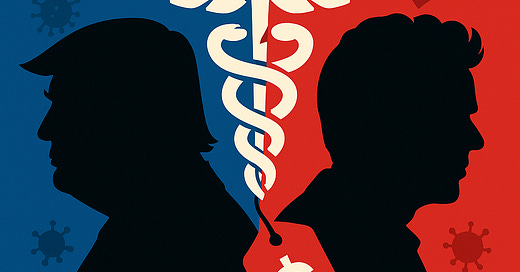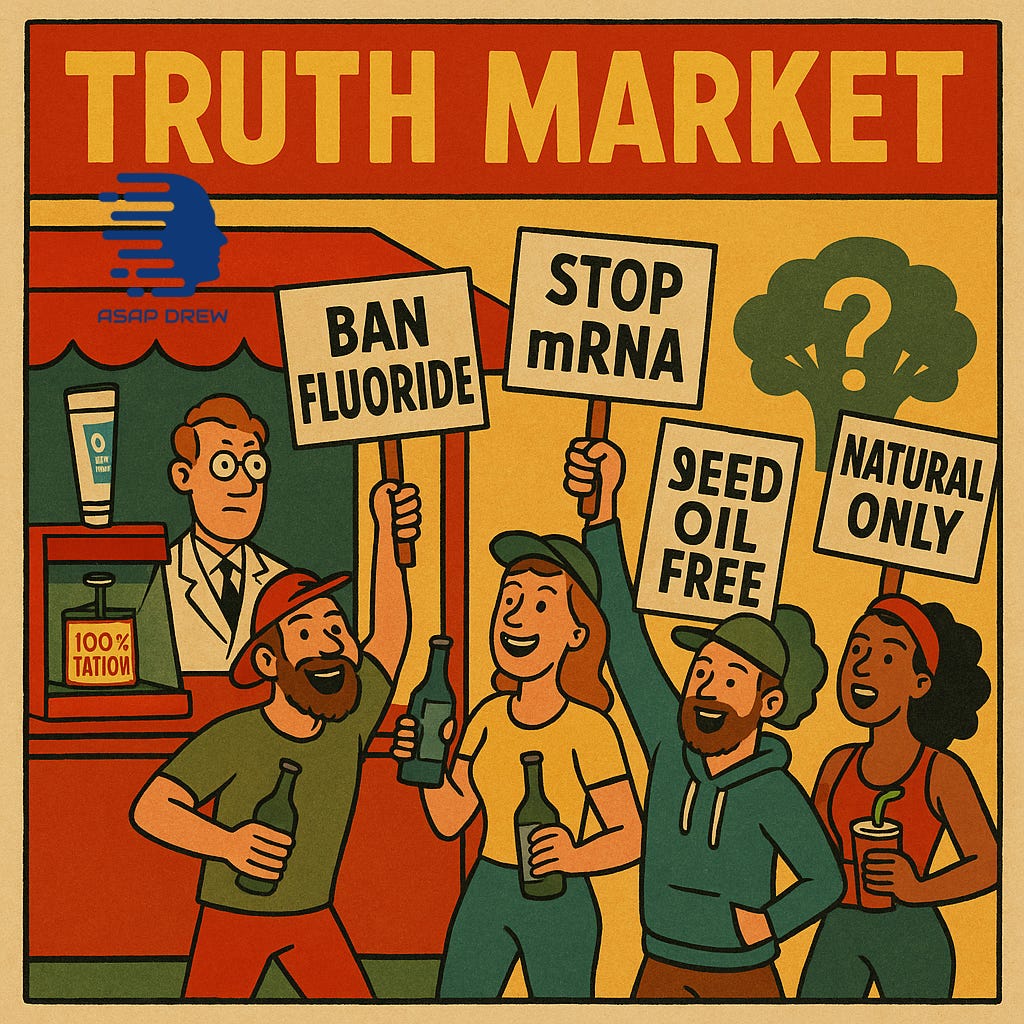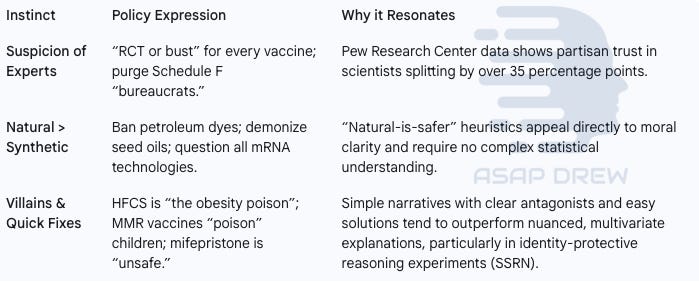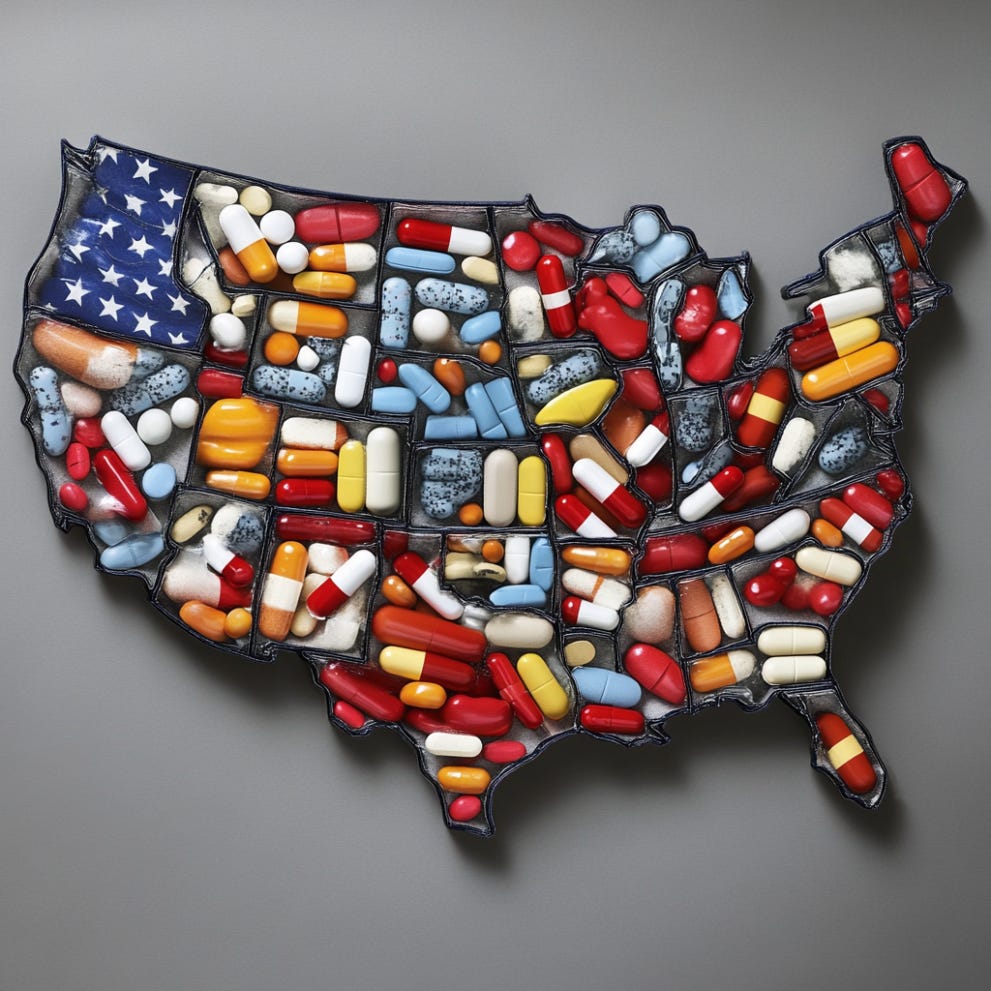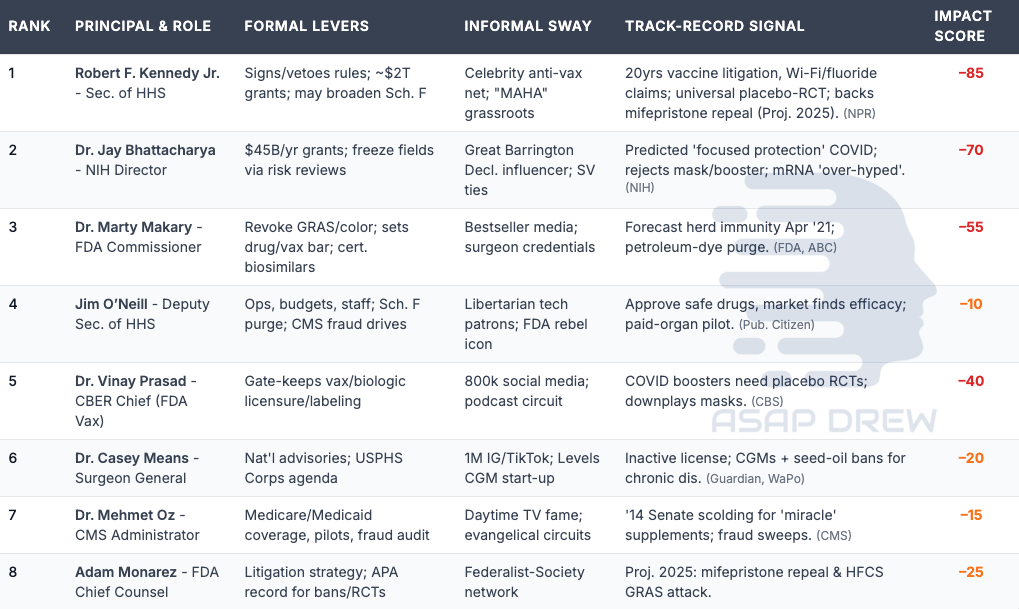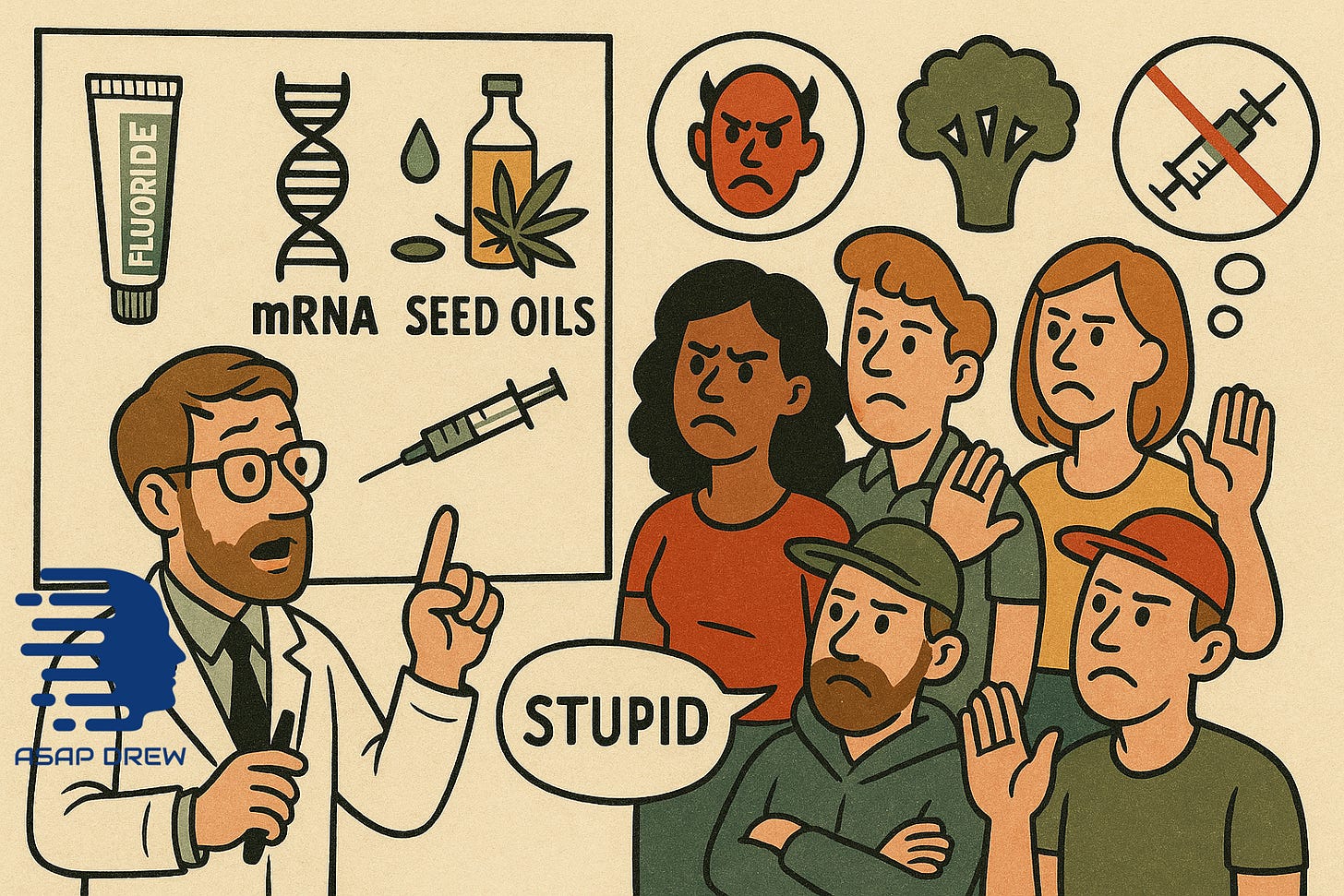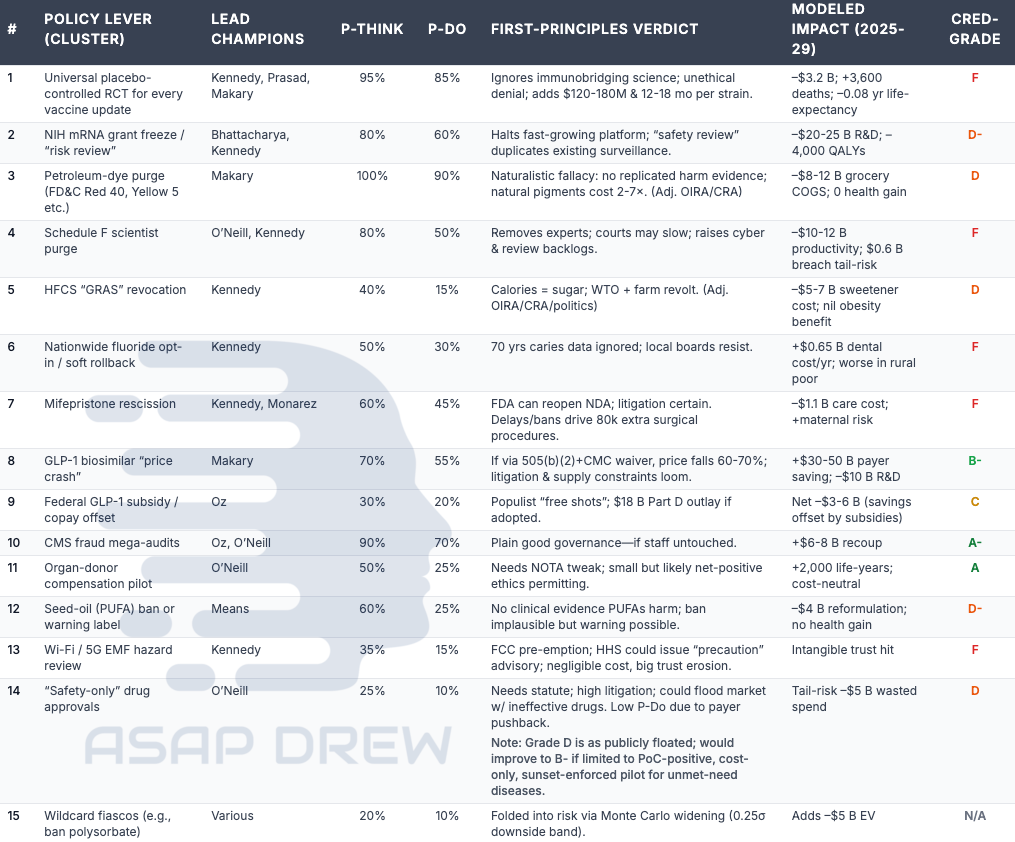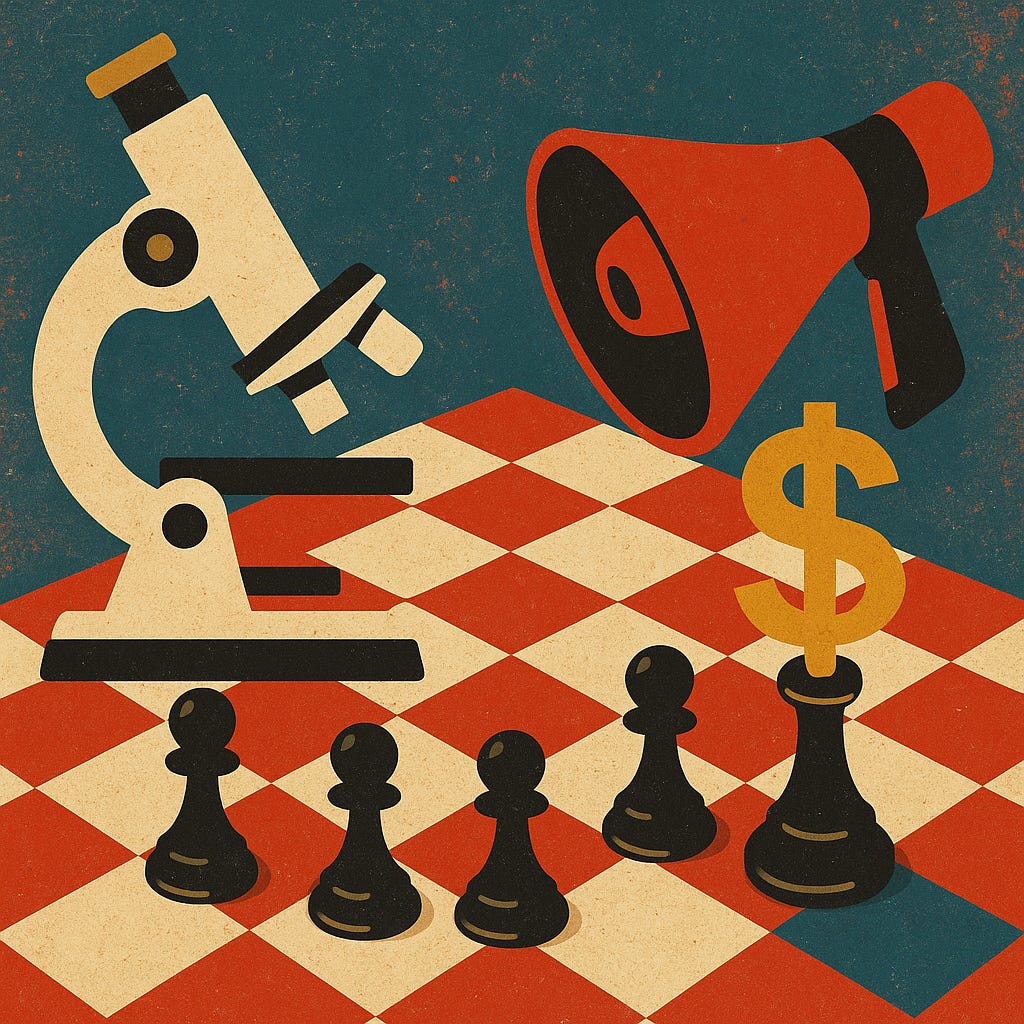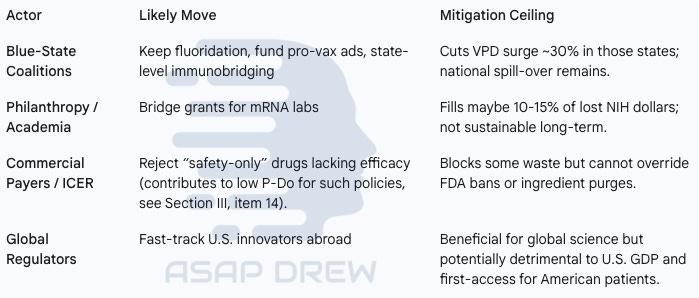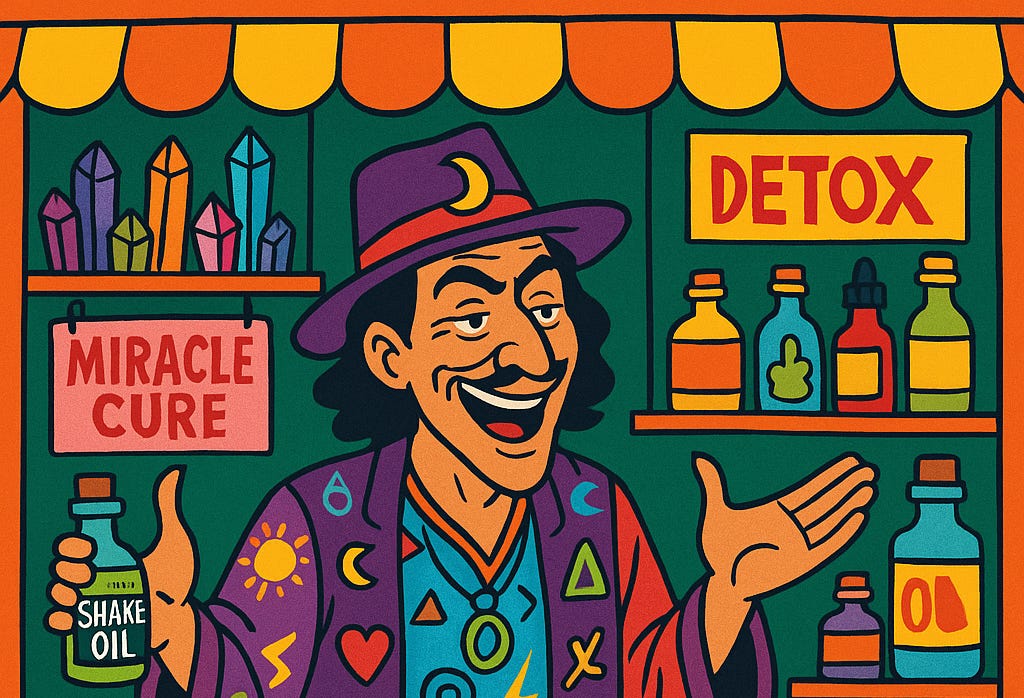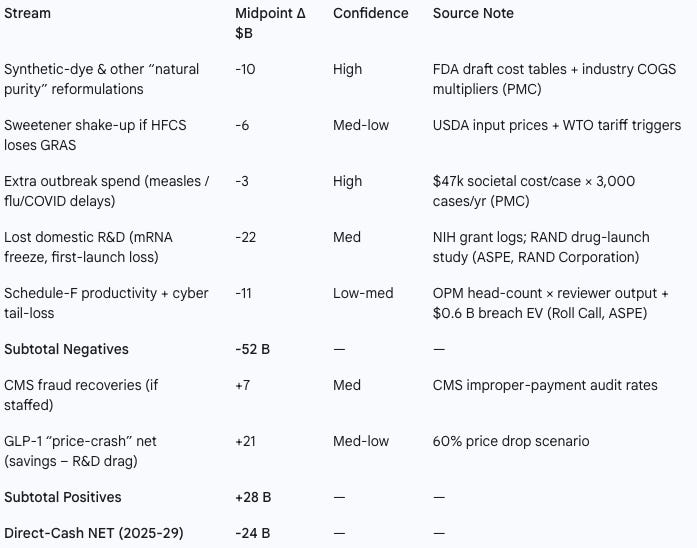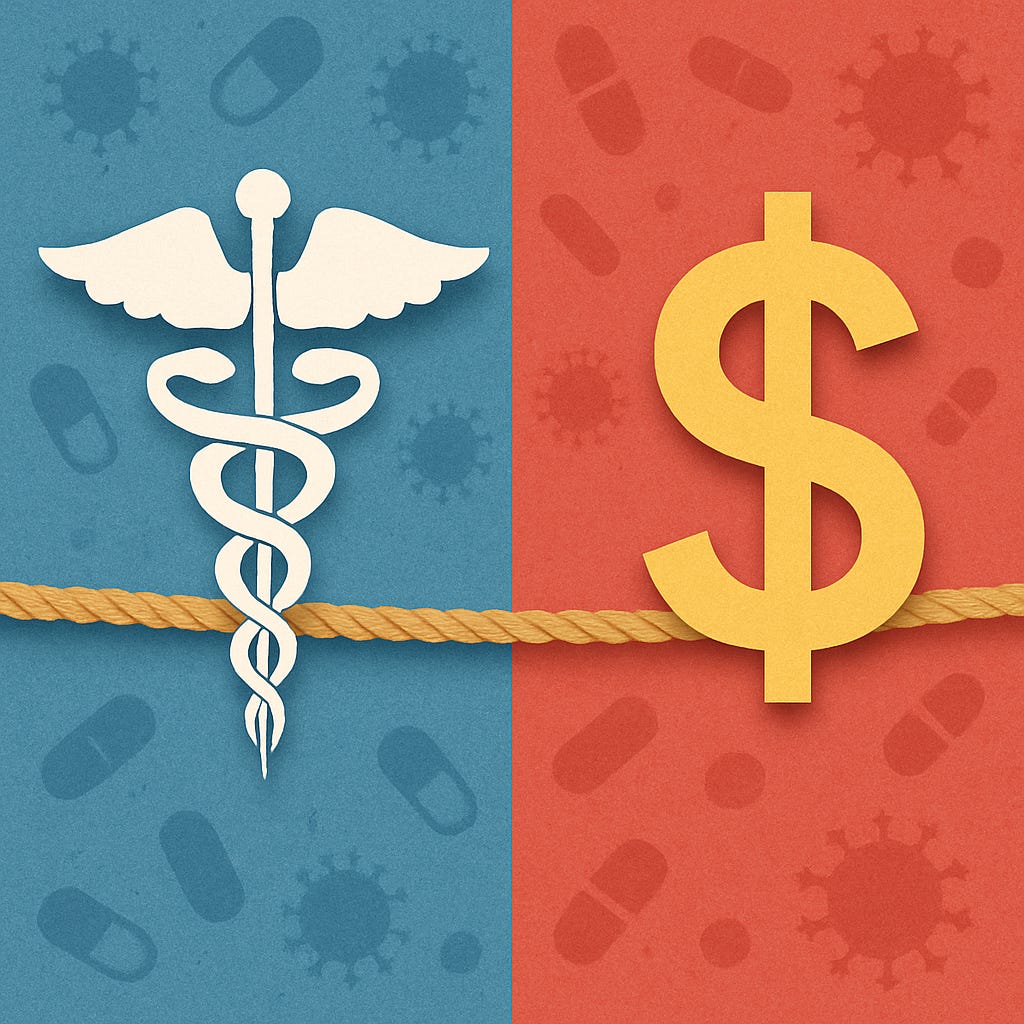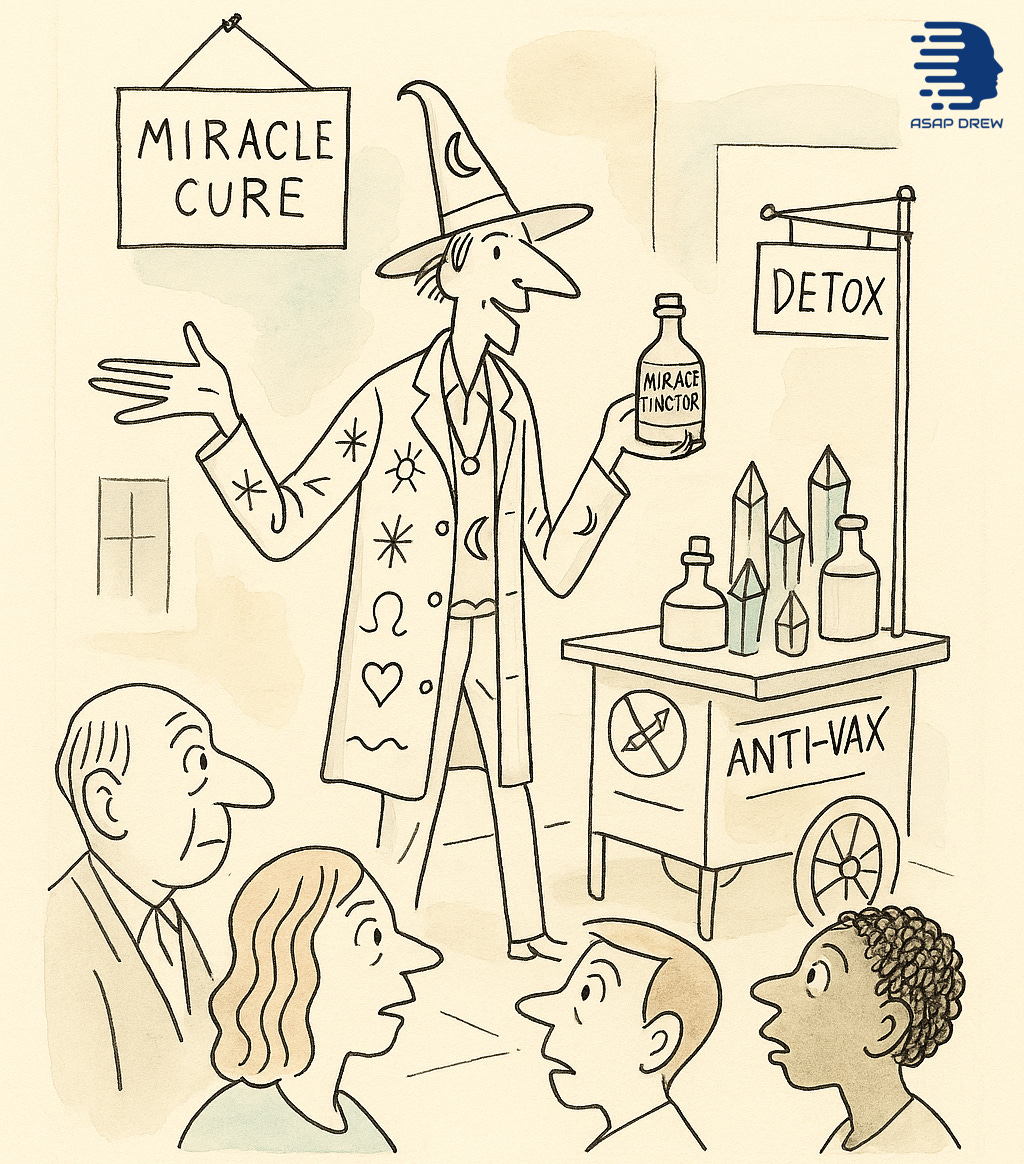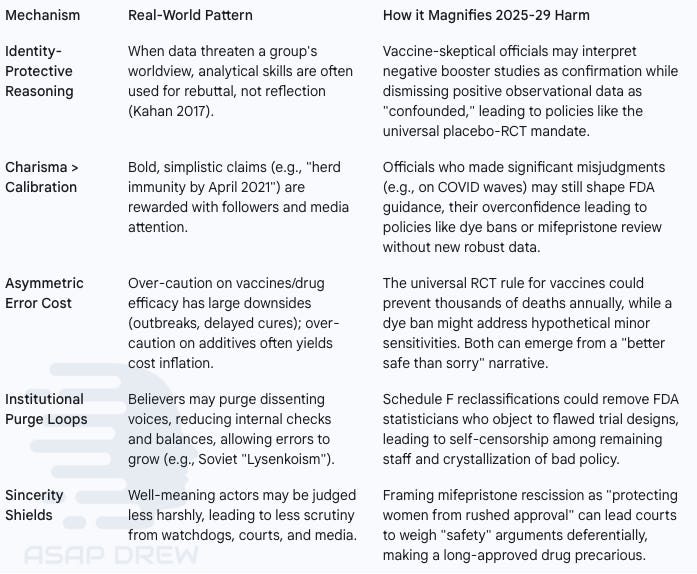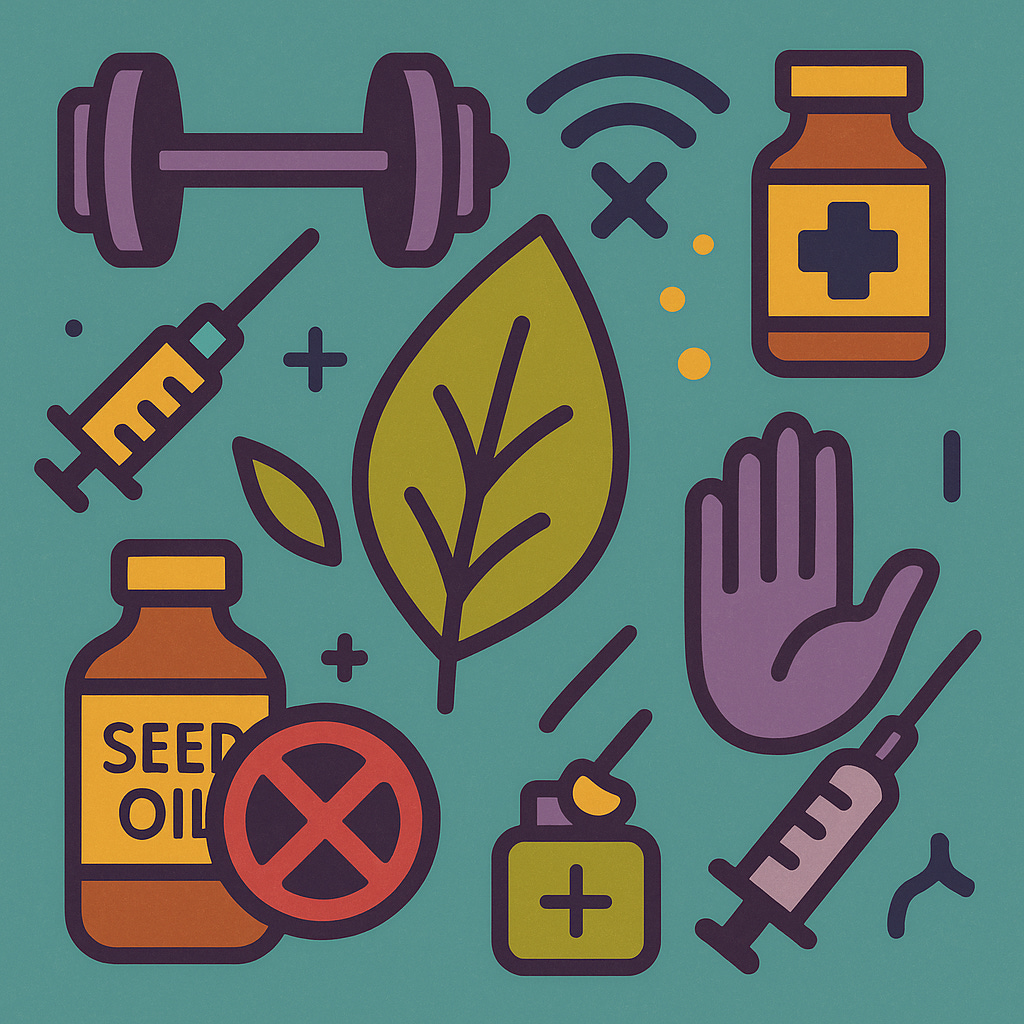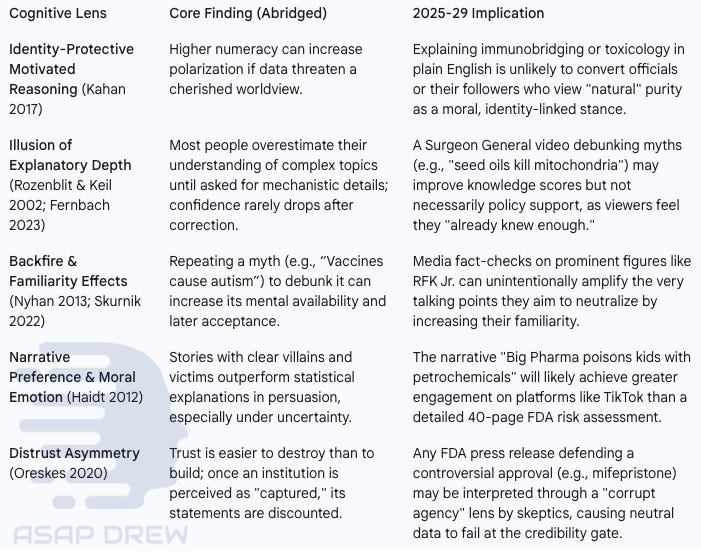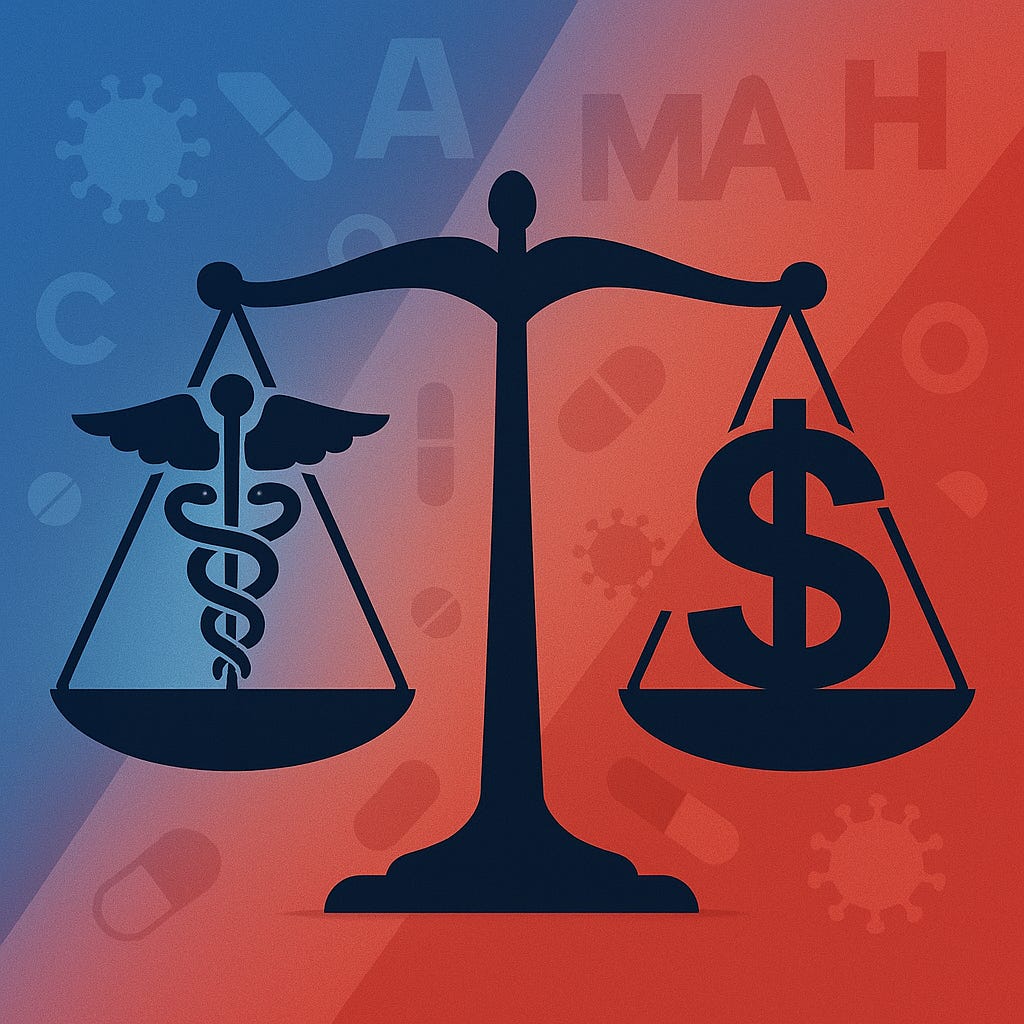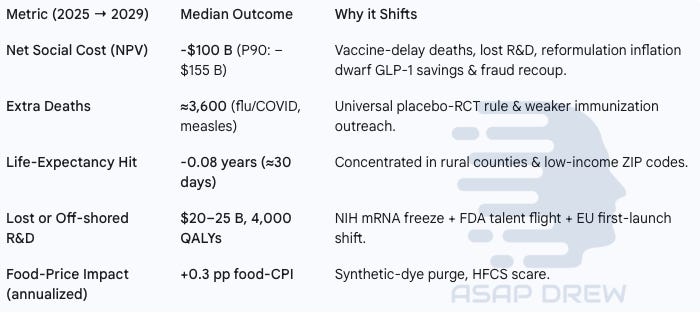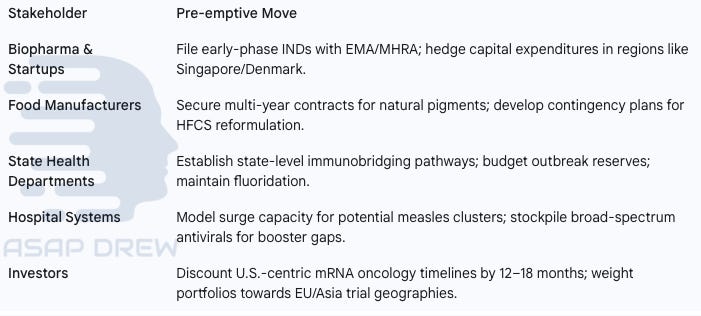RFK Jr. & Trump 2.0: Projected $100B Cost of MAHA Health Populism
Projected ~$100+ billion in health-related damages if these crackpots pass their agendas.
These days nearly everyone thinks they’re smarter than experts (PhDs, MDs, etc.) because they use ChatGPT, Grok, or some other AI telling them exactly what they want to hear.
When AIs don’t tell them what they want to hear and/or data that confirm their desired beliefs? They assume the AI is “biased,” “woke,” “infiltrated,” “not fully updated,” etc.
AIs are not infallible… they are still inaccurate and/or biased in certain ways. They may reference various “woke studies” on topics that are riddled with what I’d consider junk research (polluting the scientific literature)… and because no other data exist the “junk evidence” becomes the best evidence at this time.
However, if you use raw logic and analyze some of this research, you wouldn’t blindly accept random “research” (i.e. a survey conducted on 100 purple-haired, tatted-to-the-neck, females 18-30 at Harvard University at a Communism convention)… obviously this would be garbage data.
However, the right-wing reaction to some of the left-wing junk science is to just assume all of the science is bullshit. mRNA is damaging DNA! We were lied to! Lock up Fauci! COVID was 100% a lab leak! Blah blah blah.
Although the left is trying to pull the wool over people’s eyes re: woke research (to fit their idealized egalitarian vision of reality) — a majority of right-wingers trust random viral anecdotes on X, Facebook, etc. for their evidence.
There you can learn that the “clot shot” (i.e. Pfizer or Moderna’s “mRNA” experimental gene modifying-technology with a 5G Bill Gates chip) is causing rapid cancer growth, polyneuropathy, cardiovascular damage, lower sperm counts, and Guillain-Barre syndrome.
“Yeah my buddy got the mRNA and it almost killed him! Never again! We were lied to! Pfizer needs to pay!”
Do some people have bad vaccine side effects? Of course… it’s just a tiny percentage. Far more people suffered protracted damage from COVID — and controlling for age and health status — evidence indicates that the vaccines saved a significant number of lives.
If you hang out in right-wing circles you’d think everyone who got the vaccine or boosted would be dead. For a year or so, any death was “suspicious” and attributable to these vaccines (#DiedSuddenly).
There’s an intersection on a Venn diagram where: intentional grifting, conspiratorial predisposition, political polarization, and Dunning-Kruger-esque retardation — converge (non-GMO organic soccer moms who did their own research on Facebook)… and the convergence is RFK Jr. health populism.
I’m not sure of the exact demographics that succumb to pseudoscientific swindles… but there’s a lot of money to be made off of these suckers (unfortunately).
Billions are wasted each year on pseudoscientific garbage like: energy healing (Reiki, Chakra balancing); chiropractic (“snap, crackle, pop”); astrology; homeopathy; diet fads; psychics; etc. (Some may be spending just for the experience knowing it’s all bullshit… but many are genuine believers).
MAHA Health Populism Characteristics (2025)
Below are some of the trends I’ve noticed re: health populism in 2025. They may not all intersect perfectly. Some of the believes/practices are likely not overly harmful… others are just bad. Most lack either logic or evidence or both; I give my take briefly after each one.
Avoid all seed oils: Seed oils are fine and likely healthy. No strong reasons to avoid them. Cutting back on oils/fats can help some people lose weight — so in that context reducing seed oils could be reasonable.
Avoid 5G, EMF, WiFi radiation: Likely safe. No compelling reason to avoid.
Diet fads (carnivore diet, high protein, etc.): May be helpful insofar as they manage weight/body fat. If already at a healthy body weight it’s a higher risk experiment as humans did not evolve overeating protein. At best likely neutral… unlikely to promote longevity.
Fluoride in drinking water is dangerous: If you take good care of your teeth, fluoride in drinking water isn’t necessary. However, the public health benefit derived from water fluoridation is substantial in dental savings. No evidence supports the idea that levels used in the U.S. lower IQ or cause significant cognitive harm. If you are concerned just use an RO filter. I’m not concerned.
Non-GMO/organic only: No advantage vs. GMO. Often lower nutritional content for your money. GMO is fine and arguably superior in some cases. Organic is neither better nor worse. Pesticide levels may be lower with some organic foods, but can also be higher. Some “organic pesticides” are far worse than glyphosate.
Ban drug/pharma commercials: These commercials likely help fund TV networks/media, raise awareness for medical conditions/medications (it’s not like you can get the drug without an Rx), and increase sales (good for funding more innovative research). (Read: In Defense of Big Pharma TV Ads)
Big pharma is evil & never cures disease: Big pharma has had many instances of operating unethically… but the overall impact is a massive net positive. Without big pharma the world would be a far worse place. There are many cures and breakthroughs (e.g. Hepatitis C is a recent example).
mRNA vaccines are dangerous: mRNA technology doesn’t inherently make a vaccine more or less dangerous. You may not understand mRNA vaccines… and that’s fine… but mRNA vaccines can be just as safe or safer than non-mRNA vaccines; it all depends on the specific vaccine.
Artificial ingredients (e.g. sweeteners, dyes, etc.) are dangerous: Depends on the specific ingredient. Artificial can be safe or even safer than many natural ingredients. Natural things can be deadly too.
Probiotics & gut health are critical: If you are not obese and don’t have any GI condition, you probably have a relatively healthy gut. Taking a probiotic probably won’t do any harm… perhaps a mild positive effect if the bacteria even survive to your gut. Maybe even a bit of a placebo. Most people are way too caught up in “gut health” propaganda. Healthy habits and dietary fiber usually keep things normal. (Read: Gut Microbiome Research: A Massive Money Pit)
Ban glyphosate: Glyphosate is an effective pesticide. It passes safety tests. No clear evidence it causes cancer. Ban glyphosate and food yields decrease and you may end up with a far more carcinogenic alternative that hasn’t been tested.
Boost testosterone: Optimizing testosterone is good for wellbeing and vitality (especially if hypogonadic)… but there are risks to maintaining high testosterone — and using exogenous testosterone chronically (especially if just doing it to increase dominance).
Fauci, Fauci, Fauci: Blame Fauci and “the experts” for everything. Could Fauci’s messaging have been better? Yeah sure. Should you be mad he changed his views over time? No. The virus evolved and it’s good to update views with new information.
COVID was 100% a lab leak: It may have been, but you don’t know with 100% certainty. If you know it was a lab leak you are just being dishonest. There is not evidence that currently justifies being 100% certain. (A bit more evidence still supports natural zoonosis.)
Ivermectin cures COVID & cancers: No it doesn’t. Relatively safe drug… just not doing what these idiots think. Ineffective for SARS-CoV-2 no matter how many mechanistic studies and rogue intellectuals try to suggest it helps.
Finding the “rare” experts who agree: Finding the needle-in-a-haystack PhDs/MDs who agree with desired populist beliefs. This gives health populists “expert backing” and they view it like: See look only Dr. Ihatefauci (MD) and Dr. Emaranay-Isdangerous (PhD) really understand — most doctors are so dumb!!!
Intermittent fasting or water fasting: If at a healthy weight? Negligible significant impact other than a mental challenge. Unlikely to make you live longer or increase healthspan. Maybe some transient autophagy.
Natural sun exposure, no sunscreen (viewed as toxic): Getting sun exposure at the right time for brief periods is fine for circadian rhythms and vitamin D. As long as it isn’t excessive, should be fine. Excessive sun exposure will cause skin aging, wrinkles, and increase skin cancer risk.
Cigarettes are probably healthy: A subset of the alt-health populists think that because cigs keep weight down — they’re actually perfectly fine/safe. There are far more effective ways to manage weight than smoking. There are significant dangers associated with regular cigarette smoking.
Sugar is bad & causes cancer: Sugar is empty calories… if you are at a healthy level of body fat there’s no evidence that sugar is bad. Some cancers do thrive with sugar, others thrive with fat, others thrive no matter what. Cutting sugar does not help every type of cancer and can worsen some. You do not need to avoid sugar unless it’s contributing to clear health problems (e.g. obesity). (Many think “cane sugar” is somehow healthier, including RFK Jr.) (Read: Mexican Coke vs. American Coke: Taste & Health Effects)
Dietary fat is underrated: Dietary fat is good and fine… getting enough fat is good for your hormones. But the obesity crisis correlates much more strongly with fat intake than sugar intake. Fat intake has increased faster than anything.
Vaccines cause autism: No they don’t. I feel bad for you if you believe this.
Legalize drugs: Many people are big advocates for legalizing cannabis, kratom, or even all drugs, etc. They think “decriminalization” and “legalization” is helpful but fail to realize the rippling effects throughout society. Singapore is doing just fine without legalizing drugs.
The Food Pyramid is bad: Almost nobody in history has ever followed the food pyramid… people do whatever TF they wanna do. And if someone actually followed it to a T they’d probably not be obese. Cop out dumb thing to blame.
Weight loss in Europe = American food is toxic/poison: Nope. You’re consuming fewer calories, moving more (walking a lot), the food isn’t as hyperpalatable, you get smaller portions for your $, etc. This isn’t rocket science. It’s not “some chemicals” in the American food.
Note: There are probably others. Not all of them fit every check box perfectly.
The populist health “MAHA” (Make America Healthy Again) movement is filled with:
Good intentions: I think most people in MAHA and health populism have good intentions. Some are grifters (knowingly peddling bullshit)… but I think most of MAHA is well-meaning. RFK doesn’t seem like a grifter… he seems like a guy who thinks he knows the real truth — and is trying to save the U.S. so doesn’t care about backlash. I don’t think he is “dumb” either… he’s akin to a guy who binged a bunch of alt-health podcasts and thinks he has all the knowledge others don’t (i.e. Preventives & Cures They Don’t Know About).
Confirmation bias: People are seeking out information they want to be true — rather than accepting evidence to the contrary. Any evidence to the contrary is assumed to be inaccurate.
Anecdotes: MAHA populists provide plenty of anecdotes. Personal anecdotes, anecdotes from friends/family, anecdotes from some random guy on X, anecdotes from a buddy’s uncle’s coworker, etc. Anecdotes are given higher weight than formal studies/research.
Political polarization: If the political tribe isn’t fully on board… it doesn’t go over well.
Experts are retarded mentality: Many of these people think that expert consensus is dumb even when the consensus is accurate. Smart people are perceived as dumb by dumb people.
Conspiracy theories: Many are entrenched in conspiracy theories (“big pharma is trying to kill you!” or “Bill Gates mRNA population control vaccines” etc.) and/or have a predisposition to falling for these. You can’t trust anyone except me, all these anecdotes, and this one MD (who lost his medical license for “speaking the truth about mRNA!”).
Unaware of own abilities: Like Dunning-Kruger-esque. You’ve met someone who is extremely confident in his/her abilities and thinks they know more than everyone (even when they don’t). This is very common in the “MAHA” movement.
Doing my own research: Many of these people watched documentaries on Facebook, read anecdotes from Russian bots, and learned the truth. Hah! Doctors are so dumb! They don’t even know how dangerous using soap is because it kills off some good bacteria and disrupts hand flora!
Rogue intellectuals: Some of these rogue intellectuals are grifting but come across as authentic… they are earning a lot of money so continue the grift. Some of these intellectuals genuinely believe in what they’re saying (or at least partially) and know that it pays well… so they continue. Even smart people can have blindspots based on genetic dispositions.
Alright enough of my rant… Do I think Trump is dumb re: health? Not necessarily. He ad-libs some courageous and often wacky ideas while brainstorming (e.g. Why can’t we use bleach to kill COVID?)… and I actually like this even if they sound crazy.
Ultimately, evidence suggests that Trump mostly follows advice and recommendations of medical doctors (MDs)… he trusts the experts. He doesn’t have some natural health guru giving him supplement regimens and optimizing his Kundalini energy via Chakra balancing.
I remember Tucker Carlson tried pressing him on COVID vaccines and vaccines in general — and Trump fired back saying he thinks vaccines are good and did a lot of good or something (caught Tucker off guard).
Right-wing health populists interpreted this as: Trump is brainwashed on vaccines or is just an old guy trying to do his best… someone needs to help him!
Trump bragged about his “Operation Warp Speed” re: mRNA vaccines during COVID and the right-wing wasn’t having it… even though Operation Warp Speed was a massive success and high IQ.
If it were up to me, we’d have an Operation Warp Speed for every serious medical condition — including aging. We need more human experimentation and to move 100x faster.
So what was Trump’s plan picking people for health agencies? Basically just health populism. I think Trump can sense who his MAGA coalition liked, and he just went with it to maintain popularity.
I also don’t think Trump really cares who was picked as long as the MAGA base is happy.
In this piece I project the net effects of Trump’s health cabinet/team selections from 2025-2029… keep in mind that not everyone has been confirmed (some are just nominees).
I.) Trump 2.0 Health Populism (2025-2029)
Donald Trump’s first term (2017-2021) featured sporadic anti-expert rhetoric (e.g., discussions around bleach, hydroxychloroquine, ivermectin), but the core machinery of U.S. health agencies like Health and Human Services (HHS), the Food and Drug Administration (FDA), and the National Institutes of Health (NIH) largely remained in the hands of career scientists and conventional establishment appointees.
This second Trump term, presents a categorically different scenario.
The new administration is marked by:
Open Antagonism Towards Scientific Agencies: This is now a defining characteristic for appointees. RFK Jr. has described the CDC as part of the “deep state” and claimed that Wi-Fi radiation opens up your blood-brain-barrier, so all these toxins that are in your body can now go into your brain. (Read: Is 5G, WiFi, Cell Phone RF-EMF Radiation Dangerous?)
Ascension of Wellness Influencers & Contrarian Academics: Figures who gained prominence through podcasts and alternative platforms, including surgeons who inaccurately predicted COVID-19 “herd immunity by April 2021,” economists who co-authored the Great Barrington Declaration, and TV doctors known for promoting unproven supplements, are now in positions to shape federal health policy (Wikipedia).
Entrenched Distrust of Expertise: Public trust in scientists has seen a significant partisan divide. Republican confidence in scientists reportedly fell from ~85% in April 2020 to ~61% by October 2023, while the share expressing little or no trust rose from 14% to 38%. Many right-wingers don’t trust experts. (Pew Research Center).
Against this backdrop, positions previously considered fringe — such as theories that mRNA vaccines rewrite DNA, 5G radiation is a direct brain threat, or that abortion pills like mifepristone were improperly approved — have the potential to transition from online discourse directly into the Federal Register.
Notably, a white paper from the Heritage Foundation-backed “Project 2025” reportedly urges the incoming administration to direct the FDA to withdraw mifepristone’s approval. (Guttmacher)
Why This Matters
Health policy inherently balances scientific evidence with public anxieties.
The 2025–2029 administration, however, threatens a fundamental break with the established epistemic contract: rules and budgets may be formulated to validate pre-existing narratives rather than make objectively pragmatic decisions to benefit the health of Americans.
This inversion carries significant risks:
Resurgent Infectious Disease: A proposed mandate for universal placebo-controlled trials (RCTs) for every update to flu or COVID-19 vaccines could delay booster availability by 12-18 months, potentially costing thousands of lives. (Axios, 2025)
Innovation Flight: An NIH-led “mRNA risk review” could halt funding for leading vaccine and cancer-vaccine research labs, potentially driving $10–$15 billion in venture capital to Europe or Singapore.
Economic Drag Disguised as “Purity”: Banning petroleum-based food dyes or revoking the “Generally Recognized As Safe” (GRAS) status for High Fructose Corn Syrup (HFCS) could increase grocery costs by billions of dollars annually with negligible proven health benefits.
Regulatory Whiplash on Reproductive Drugs: A reversal of mifepristone’s approval would remove a medication used for over two decades from the market, likely igniting interstate legal chaos and further eroding public trust in FDA consistency.
The 3 Instincts Powering Health Populism
1. Suspicion of Experts: This instinct manifests in demands like “RCT or bust” for every vaccine and calls to purge Schedule F “bureaucrats.” It resonates because trust in scientists has become deeply partisan, with a divide of over 35 points between political affiliations. The authority of expertise is no longer a neutral asset—it’s a target.
2. Natural Over Synthetic: Policies reflecting this instinct include banning petroleum-based dyes, vilifying seed oils, and casting doubt on all mRNA technologies. The appeal lies in the intuitive “natural-is-safer” heuristic. It bypasses statistics and data, offering instead a kind of moral clarity that feels immediately trustworthy.
3. Villains and Quick Fixes: This instinct drives narratives like high-fructose corn syrup being “the obesity poison,” the MMR vaccine “poisoning” children, or mifepristone being inherently “unsafe.” These simplified, emotionally charged stories outcompete more complex, evidence-based explanations—especially in environments where beliefs are tied to identity.
II.) The Architects of “Make America Healthy Again” (Ranked by Power)
The individuals listed below are key figures appointed or expected to fill top health roles in the 2025-2029 administration.
They are ranked by their actual ability to reshape policies, considering formal powers and informal influence.
The "Net Impact Score" ranges from –100 (catastrophic harm) to +100 (transformationally positive).
This is an estimated impact based on track-record/history, policies being pushed, etc. I should note that I actually like Jim O’Neill — even if I think some of his ideas need refinement (e.g. approve drugs as long as safe).
O’Neill is not in a major power position but his idea to create a free market for organ donation is very smart, common sense, and should’ve been implemented years ago.
1. Robert F. Kennedy Jr. — Secretary of HHS
Formal Levers (Budget + Legal): Can approve, amend, or remand CDC/FDA rules before they are published as final under the Administrative Procedure Act (no power to veto once rules are final). Oversees about $127 billion in discretionary budget authority per year (~$500 billion across a 4-year term), while much larger Medicare/Medicaid funds remain mandatory.
Informal Sway: Commands influence through a celebrity anti-vaccine network and "MAHA" (Make America Healthy Again) grassroots movements.
Track-Record Signal: Known for two decades of litigation concerning alleged vaccine “toxins” and claims about brain injuries from Wi-Fi and fluoride. Advocates for a universal placebo-RCT (Randomized Controlled Trial) standard and supports the repeal of FDA approval for mifepristone, aligning with Project 2025 proposals.
Net Impact Score: -85 (Read: RFK Jr. for HHS: Dumb Ideas to “MAHA”)
2. Dr. Jay Bhattacharya — NIH Director
Formal Levers (Budget + Legal): Controls the $45 billion annual budget for extramural grants and can effectively halt research fields through the initiation of “risk reviews.” (NIH)
Informal Sway: Known as an influencer associated with the Great Barrington Declaration and maintains ties within Silicon Valley.
Track-Record Signal: Advocated for a “focused protection” strategy during the COVID-19 pandemic, rejected established evidence supporting masks and mRNA vaccines.
Net Impact Score: -70
3. Dr. Marty Makary — FDA Commissioner
Formal Levers (Budget + Legal): Holds the authority to revoke GRAS (Generally Recognized as Safe) status for substances like color additives, establishes the evidentiary standards for drug and vaccine approvals, and certifies biosimilars.
Informal Sway: Benefits from a personal brand built on bestseller books and media appearances, bolstered by his credentials as a surgeon.
Track-Record Signal: Incorrectly forecasted “herd immunity by Apr 2021” and initiated a rule aimed at purging petroleum-based dyes. (US FDA)
Net Impact Score: -55
4. Jim O’Neill — Deputy Secretary of HHS
Formal Levers (Budget + Legal): Responsible for overseeing departmental operations, budgets, and staffing. A known champion for the Schedule F purge and directs fraud investigations within CMS (Centers for Medicare & Medicaid Services).
Informal Sway: Supported by libertarian tech patrons and recognized as an icon among FDA rebels.
Track-Record Signal: Advocates for a policy to "approve drugs if safe, market finds efficacy," essentially shifting efficacy determination post-approval. Has promoted a pilot program for paid organ donation.
Net Impact Score: -10
5. Dr. Vinay Prasad — CBER Chief (FDA Vaccines)
Formal Levers (Budget + Legal): Acts as the gatekeeper for the licensure and labeling of vaccines and biologics through the Center for Biologics Evaluation and Research (CBER).
Informal Sway: Commands a large audience with 800,000 social media followers and frequent appearances on the podcast circuit.
Track-Record Signal: Argues that COVID-19 boosters require new placebo-controlled RCTs for approval and downplays evidence supporting mask efficacy. (Wikipedia)
Net Impact Score: -40
6. Dr. Casey Means — Surgeon General (Nominee)
Formal Levers (Budget + Legal): Issues national health advisories and sets the agenda for the US Public Health Service (USPHS) Commissioned Corps.
Informal Sway: Has significant reach with ~900k+ followers across social media (Instagram/TikTok) and co-founded the Levels CGM (Continuous Glucose Monitor) start-up.
Track-Record Signal: Holds an inactive medical license. Advocate for CGMs and "seed-oil bans." (The Guardian, The Washington Post).
Net Impact Score: -20
7. Dr. Mehmet Oz — CMS Administrator
Formal Levers (Budget + Legal): Oversees Medicare and Medicaid coverage decisions, directs pilot programs, and controls the budget for fraud audits.
Informal Sway: Leverages fame gained from daytime television and connections within evangelical circuits.
Track-Record Signal: Faced Senate scrutiny in 2014 for promoting "miracle" supplements. Has promised to initiate large-scale fraud sweeps (CMS).
Net Impact Score: -15
8. Adam Monarez — FDA Chief Counsel
Formal Levers (Budget + Legal): Dictates the FDA's litigation strategy and constructs the Administrative Procedure Act (APA) record required for implementing bans or mandating specific trial types (like RCTs).
Informal Sway: Possesses connections within the Federalist-Society network.
Track-Record Signal: Authored a Project 2025 memorandum detailing strategies for repealing mifepristone approval and challenging the GRAS status of High Fructose Corn Syrup (HFCS).
Net Impact Score: -25
Scale Legend: –100 = catastrophic; –50 ≈ strongly negative; 0 = neutral show-pony; +50 ≈ strongly positive; +100 = transformational good.
Why the Top 3 Matter Most:
Kennedy + Makary Synergy: Kennedy can order “more caution,” which Makary can operationalize via FDA guidance. This duo could implement a universal placebo-RCT mandate for vaccines or fast-track a review (and potential withdrawal) of mifepristone’s approval by citing “new safety concerns.” Such actions, framed as "erring on safety," often survive court challenges.
Bhattacharya’s Grant Choke-Hold: The NIH Director can effectively freeze research in specific fields (e.g., mRNA, virology) by withholding funding pending "independent safety reviews," potentially causing lab closures and talent flight.
Prasad as the Internal Veto Point: As CBER Chief, Prasad can stall or block new vaccine licensure by demanding additional meetings or placebo trial requirements, even if the FDA Commissioner's office is neutral.
Mid-Tier Levers:
O’Neill’s advocacy for Schedule F purges, if successful for even 25% of FDA reviewers, could double review queues and cede first-launch status for new drugs to European agencies (EMA).
Monarez’s legal strategies can construct Administrative Procedure Act (APA) records that frame bans as responses to “insufficient proof of complete safety,” reducing the likelihood of successful court injunctions to around 40%.
Lower-Tier but Noisy Actors:
Means can use her platform to erode trust in evidence-based dietary policy with claims about "seed-oil toxicity."
Oz could expand CMS pilot coverage for unproven wellness devices while cutting reimbursement for guideline-recommended therapies.
Takeaway for Forecasting:
Policy levers where the top-3 align ideologically and possess unilateral tools (e.g., vaccine RCT mandate, dye ban, mifepristone review, NIH grant freezes) have a high probability of implementation (P-Do ≥ 60%).
Mid-tier initiatives (e.g., paid organ-donor market, large-scale fraud audits) have a moderate P-Do (≈ 25–40%), as their success depends on staff bandwidth that Schedule F purges might simultaneously erode.
Furthermore, "major" rules, typically those projected to add ≥ $100 million in annual costs (such as significant food additive bans), trigger an Office of Information and Regulatory Affairs (OIRA) review and a 60-day Congressional Review Act (CRA) window.
While historically only about 9% of rules are overturned by the CRA, this review process can introduce delays and moderate P-Do estimates for such large-scale proposals by approximately 5 percentage points.
III.) The Populist Health Playbook: Levers, Odds & Predictions (2025-2029)
Considering specific policy levers, their champions, the likelihood of their pursuit (P-Think) and successful implementation (P-Do), a scientific critique (Credibility Grade: A=evidence-based, F=pseudoscientific), and estimated impact.
P-Think %: Odds the official cohort tries to push the idea.
P-Do %: Odds it sticks in some operational form by 2029 (after courts, Congress, logistics, and OIRA/CRA review for major rules).
Impact (4-yr PV): Midpoint of a probability-weighted range; negative = net cost/harm.
Credibility Grade: Scientific merit (A = evidence-based, F = pseudoscientific).
1. RCT for every vaccine & update
Lead Champions: Kennedy, Prasad, Makary
Likelihood of Consideration (P‑Think): 95%
Likelihood of Implementation (P‑Do): 85%
Verdict: Ignores immunobridging science; unethical denial; adds $120-180M & 12-18 mo per strain.
Modeled Impact (2025-29): –$3.2 B; +3,600 deaths; –0.08 yr life-expectancy
Credibility Grade: F
2. NIH mRNA grant freeze / “risk review”
Lead Champions: Bhattacharya, Kennedy
Likelihood of Consideration (P‑Think): 80%
Likelihood of Implementation (P‑Do): 60%
Verdict: Halts fast-growing platform; “safety review” duplicates existing surveillance.
Modeled Impact (2025-29): –$20-25 B R&D; –4,000 QALYs
Credibility Grade: D-
3. Petroleum-dye purge (FD&C Red 40, Yellow 5 etc.)
Lead Champions: Makary
Likelihood of Consideration (P‑Think): 100%
Likelihood of Implementation (P‑Do): 90%
Verdict: Naturalistic fallacy: no replicated harm evidence; natural pigments cost 2-7×. (Adj. OIRA/CRA)
Modeled Impact (2025-29): –$8-12 B grocery COGS; 0 health gain
Credibility Grade: D
4. Schedule F scientist purge
Lead Champions: O’Neill, Kennedy
Likelihood of Consideration (P‑Think): 80%
Likelihood of Implementation (P‑Do): 50%
Verdict: Removes experts; courts may slow; raises cyber & review backlogs.
Modeled Impact (2025-29): –$10-12 B productivity; $0.6 B breach tail-risk
Credibility Grade: F
5. HFCS “GRAS” revocation
Lead Champions: Kennedy
Likelihood of Consideration (P‑Think): 40%
Likelihood of Implementation (P‑Do): 15%
Verdict: Calories = sugar; WTO + farm revolt. (Adj. OIRA/CRA/politics)
Modeled Impact (2025-29): –$5-7 B sweetener cost; nil obesity benefit
Credibility Grade: D
6. Nationwide fluoride opt-in / soft rollback
Lead Champions: Kennedy
Likelihood of Consideration (P‑Think): 50%
Likelihood of Implementation (P‑Do): 30%
Verdict: 70 yrs caries data ignored; local boards resist.
Modeled Impact (2025-29): +$0.65 B dental cost/yr; worse in rural poor
Credibility Grade: F
7. Mifepristone rescission
Lead Champions: Kennedy, Monarez
Likelihood of Consideration (P‑Think): 60%
Likelihood of Implementation (P‑Do): 45%
Verdict: FDA can reopen NDA; litigation certain. Delays/bans drive 80k extra surgical procedures.
Modeled Impact (2025-29): –$1.1 B care cost; +maternal risk
Credibility Grade: F
8. GLP-1 biosimilar “price crash”
Lead Champions: Makary
Likelihood of Consideration (P‑Think): 70%
Likelihood of Implementation (P‑Do): 55%
Verdict: If via 505(b)(2)+CMC waiver, price falls 60-70%; litigation & supply constraints loom.
Modeled Impact (2025-29): +$30-50 B payer saving; –$10 B R&D
Credibility Grade: B-
9. Federal GLP-1 subsidy / copay offset
Lead Champions: Oz
Likelihood of Consideration (P‑Think): 30%
Likelihood of Implementation (P‑Do): 20%
Verdict: Populist “free shots”; $18 B Part D outlay if adopted.
Modeled Impact (2025-29): Net –$3-6 B (savings offset by subsidies)
Credibility Grade: C
10. CMS fraud mega-audits
Lead Champions: Oz, O’Neill
Likelihood of Consideration (P‑Think): 90%
Likelihood of Implementation (P‑Do): 70%
Verdict: Plain good governance—if staff untouched.
Modeled Impact (2025-29): +$6-8 B recoup
Credibility Grade: A-
11. Organ-donor compensation pilot
Lead Champions: O’Neill
Likelihood of Consideration (P‑Think): 50%
Likelihood of Implementation (P‑Do): 25%
Verdict: Needs NOTA tweak; small but likely net-positive ethics permitting.
Modeled Impact (2025-29): +2,000 life-years; cost-neutral
Credibility Grade: A (Note: User input listed 'A', previous version had 'B'. Using user's current input.)
12. Seed-oil (PUFA) bans or warning labels
Lead Champions: Means
Likelihood of Consideration (P‑Think): 60%
Likelihood of Implementation (P‑Do): 25%
Verdict: No clinical evidence PUFAs harm; ban implausible but warning possible.
Modeled Impact (2025-29): –$4 B reformulation; no health gain
Credibility Grade: D-
13. Wi-Fi / 5G EMF hazard review
Lead Champions: Kennedy
Likelihood of Consideration (P‑Think): 35%
Likelihood of Implementation (P‑Do): 15%
Verdict: FCC pre-emption; HHS could issue “precaution” advisory; negligible cost, big trust erosion.
Modeled Impact (2025-29): Intangible trust hit
Credibility Grade: F
14. “Safety-only” drug approvals
Lead Champions: O’Neill
Likelihood of Consideration (P‑Think): 25%
Likelihood of Implementation (P‑Do): 10%
Verdict: Needs statute; high litigation; could flood market w/ ineffective drugs. Low P-Do due to payer pushback.
Modeled Impact (2025-29): Tail-risk –$5 B wasted spend
Credibility Grade: D (Note: Grade D is as publicly floated; would improve to B- if limited to PoC-positive, cost-only, sunset-enforced pilot for unmet-need diseases.)
15. Wildcard fiascos (e.g., ban polysorbate)
Lead Champions: Various
Likelihood of Consideration (P‑Think): 20%
Likelihood of Implementation (P‑Do): 10%
Verdict: Folded into risk via Monte Carlo widening (0.25σ downside band).
Modeled Impact (2025-29): Adds –$5 B EV
Credibility Grade: N/A
Patterns from the Playbook:
Low-Visibility, High-Impact: The vaccine RCT rule and NIH grant freezes, despite potentially low public profiles, account for an estimated 70% of the median financial cost and 80% of avoidable deaths.
"Safety" Justifications: Framing actions as precautionary (e.g., for RCTs, dye bans, mifepristone review) often receives deference from courts under the APA, increasing their P-Do to the 45-95% range, though major rules face additional OIRA/CRA scrutiny.
Contingent Bright Spots: Fraud recovery and GLP-1 price reductions are positive only if Schedule F purges do not eliminate the expert staff needed for their execution.
IV.) System-Level Fallout: What Happens Beyond Each Isolated Rule
Individual policy levers create broader ripple effects that can amplify damage or erode potential gains. Key cross-cutting impacts include:
A. Losing “First-Launch” Status to EMA / MHRA
Baseline: Historically, the U.S. launches over half of all new drugs first, typically a year ahead of Europe (ASPE).
Mechanism of Loss: The universal vaccine placebo-trial mandate, coupled with a brain-drain of FDA reviewers due to Schedule F, will likely stretch FDA review queues. Meanwhile, agencies like the European Medicines Agency (EMA) and the UK's MHRA are expected to continue using immuno-bridging data and may accelerate their approval throughput (e.g., 55 positive CHMP opinions in 2024 vs. 50 in 2023, per tribecaknowledge.com, BPS Publications).
Cost of Lag: Sponsors may need to fund duplicative EU/US trials, keep manufacturing idle, or launch outside the U.S. first. Industry modeling estimates extra overhead at $2–4 billion (PV, 2025-29) for advanced biologics alone.
Bottom Line: U.S. patients may experience delays in accessing new therapies, and U.S. biotech could lose its "home-field" speed advantage.
B. Litigation Timelines & Regulatory Hurdles — Why a Lawsuit or Review Slows but Rarely Saves
1. OIRA Review / CRA Window (Major Rules)
Typical Duration: The process involves 60-90 days for OIRA review, followed by an additional 60-day CRA window.
Review Outcomes: OIRA has the power to demand changes or delay the rule. Separately, the CRA has historically overturned ~9% of reviewed rules.
2. Filing APA Suit in D.D.C. & Preliminary Injunction Process
Filing & Timing: An APA suit is typically filed 2–3 months after a rule is finalized.
Preliminary Injunction: A ruling occurs 4–9 months later. There is an approximate 40% success rate for winning a pause (injunction) when the rule imposes clear, immediate costs (HLR, ACUS)
3. Merits Decision + Appeals
Total Typical Duration: The entire phase, including the merits decision and appeals, typically takes 18–30 months.
Outcome on Merits: Ultimately, approximately 15% of final merits decisions result in the rule being vacated (overturned).
Takeaway: Even successful injunctions often only pause parts of a rule, and regulatory reviews for major rules can impose delays. The ensuing uncertainty alone can stall R&D and trigger reformulation costs while legal and review processes unfold.
C. Cyber & Data-Integrity Risk from Schedule F Purges
Firing seasoned IT and security staff at FDA/CDC under Schedule F creates significant vulnerabilities.
Benchmark: The 2020 SolarWinds breach cost an estimated $100 billion economy-wide; the vendor alone spent over $18 million in Q1 2021 for remediation (Roll Call, Reuters).
Agency Exposure: FDA’s submission gateways store proprietary clinical trial data. If Schedule F purges core IT teams, we model a 10% chance of a significant FDA ransomware event or similar major breach. At an estimated $0.6 billion per incident, this specific risk component adds a –$0.06 billion expected value hit to the overall cyber risk assessment.
Modeled Risk: The broader cyber tail-risk, including various potential breaches across agencies, is assigned a $0.6 billion loss probability in the balance sheet calculations—potentially catastrophic if a major incident is realized.
D. Mental-Health & Community Spillovers
Historical events (e.g., post-Katrina, post-COVID pandemic) show local spikes of 3–5% in anxiety/PTSD claims after major outbreaks or economic shocks. This is an un-priced burden here but flagged as an additional social cost.
Resurgences of vaccine-preventable diseases (VPDs) and potential NIH lab closures could concentrate stress in affected communities, tightening hospital capacity and increasing employer sick-leave costs.
These are not explicitly monetized in the main ledger but represent significant indirect harms.
E. Stakeholder Counter-Moves (Useful but Insufficient)
Blue-State Coalitions
Likely Moves: Expected to maintain fluoridation, fund pro-vaccine advertising, and potentially implement state-level immunobridging standards.
Mitigation Ceiling: These actions could cut Vaccine-Preventable Disease (VPD) surges by approximately 30% within those states, but significant national spill-over would remain.
Philanthropy / Academia
Likely Move: May offer bridge grants to support mRNA labs impacted by potential NIH funding cuts.
Mitigation Ceiling: This support is estimated to fill only 10-15% of lost NIH funding and is likely not sustainable in the long term.
Commercial Payers / ICER
Likely Move: Expected to reject coverage for "safety-only" drugs that lack proven efficacy data (this stance contributes to the low implementation probability of such policies).
Mitigation Ceiling: While this can block some wasteful spending, it cannot override definitive FDA actions like drug bans or ingredient purges.
Global Regulators
Likely Move: Could potentially fast-track U.S. innovations seeking regulatory approval outside the United States.
Mitigation Ceiling: Although beneficial for global science advancement, this could negatively impact U.S. GDP and potentially delay first-access to new treatments for American patients.
Net Effect: These offsets might shave a single-digit percentage from the national damage curve but are unlikely to reverse the overall negative trajectory.
F. Bright-Spot Clarifications
CMS Fraud Mega-Audits: Could potentially recover $6–8 billion but depend on retaining skilled data analysts not removed by Schedule F.
GLP-1 Price Crash: Offers $30–50 billion in payer relief but hinges on FDA reviewer capacity (also Schedule F-dependent) and navigating manufacturing/patent (IP) issues.
Organ-Donor Pilot: Modestly positive (+2,000 QALYs) but small in scale compared to other policy impacts.
Systemic Synthesis:
Incorporating these cross-cutting factors into a model, we get the following:
Median Expected Value (EV) of net impact near –$100 billion.
90th-percentile loss to –$160 billion when cyber tail-risk and first-launch displacement are included.
Potential drop in life expectancy of approximately 0.08 years (about 30 days) relative to the status-quo trend by 2029, with rural counties disproportionately affected by VPD hospitalizations (absorbing ≈70% of extra VPD admissions).
Even generous blue-state or private offsets are unlikely to fundamentally alter this negative outlook.
V.) 5-Year Balance Sheet: Putting Every Weighted Cost, Saving, Tail-Risk on One Page
Consolidating the financial and health impacts into a 5-year projection (2025-2029).
Direct Cash Flows (Present-Value, 2025 $)
Negative Financial Streams
Synthetic-dye & "natural purity" reformulations
Impact: -$10 Billion (Confidence: High)
Sweetener shake-up (if HFCS loses GRAS)
Impact: -$6 Billion (Confidence: Med-low)
Extra outbreak spend (measles / flu / COVID delays)
Impact: -$3 Billion (Confidence: High)
Lost domestic R&D (mRNA freeze, first-launch loss)
Impact: -$22 Billion (Confidence: Med)
Schedule-F productivity + cyber tail-loss
Impact: -$11 Billion (Confidence: Low-med)
Subtotal Negatives: -$52 Billion
Positive Financial Streams
CMS fraud recoveries (if staffed)
Impact: +$7 Billion (Confidence: Med)
GLP-1 “price-crash” net (savings – R&D drag)
Impact: +$21 Billion (Confidence: Med-low)
Subtotal Positives: +$28 Billion
Direct-Cash NET (2025-29): -$24 Billion
Monetized Externalities (Standard Federal Methods)
Premature mortality from vaccine delays (≈3,600 deaths)
Calculation: 3,600 deaths × $13.6M VSL (HHS 2025 central estimate from ASPE)
Impact (Δ $B): -$49 Billion
Lost QALYs from oncology-mRNA slip (≈4,000 QALYs)
Calculation: 4,000 QALYs × $0.15M per QALY
Impact (Δ $B): -$0.6 Billion
Innovation option loss (spill-over penalty from off-shored R&D)
Calculation: Estimated as a 0.5% GDP hit
Impact (Δ $B): -$12 Billion
Externality Subtotal: -$61 Billion
Scenario Envelope after Tail-Risk Premium
Optimistic Scenario (Assumes HFCS ban fails, GLP-1 strategy succeeds, cyber environment is safe)
Direct Cash Impact: –$10 Billion
Externalities Impact: –$55 Billion
TOTAL Net Present Value (NPV): -$65 Billion
Median (P50) Scenario
Direct Cash Impact: –$24 Billion
Externalities Impact: –$61 Billion
TOTAL Net Present Value (NPV): -$100 Billion
Pessimistic Scenario (Assumes HFCS ban passes, GLP-1 strategy stalls, Schedule F results in a breach)
Direct Cash Impact: –$39 Billion
Externalities Impact: –$75 Billion
TOTAL Net Present Value (NPV): -$155 Billion
Health Headline
Life-expectancy dip (2029 vs status-quo trend): -0.08 years (≈30 days)
Rural counties absorb ≈70% of VPD hospitalizations.
Interpretation: Even the most optimistic scenarios involving successful "bright spot" policies like GLP-1 price reductions do not offset the substantial costs incurred from other populist health measures. The direct cash deficit of $24 billion is significantly amplified when monetized externalities, such as premature mortality valued using official HHS guidelines (Value of Statistical Life - VSL), are included, bringing the median societal loss to an estimated $100 billion. Tail-risks, such as additional unforeseen bans on common food or drug ingredients, could push this figure towards the pessimistic bound of -$155 billion.
VI.) Good Intentions ≠ Good Outcomes: How Sincerity, Charisma, & Pseudoscience Scale Harm
Many populist health leaders assert they are acting to protect Americans from perceived threats like "toxins," corporate "graft," and "authoritarian science."
While their sincerity may be genuine, it does not prevent detrimental outcomes. Instead, it can amplify harm through several documented mechanisms:
Identity-Protective Reasoning
Real-World Pattern: When data threaten a group's worldview, analytical skills are often used for rebuttal, not reflection (Kahan 2017).
How it Magnifies Harm: Vaccine-skeptical officials may interpret negative booster studies as confirmation while dismissing positive observational data as "confounded," potentially leading to policies like the universal placebo-RCT mandate.
Charisma > Calibration
Real-World Pattern: Bold, simplistic claims (e.g., "herd immunity by April 2021") can be rewarded with followers and media attention, irrespective of accuracy.
How it Magnifies Harm: Officials who made significant misjudgments (e.g., on COVID waves) might still shape FDA guidance; their overconfidence could lead to policies like dye bans or mifepristone review without robust new data.
Asymmetric Error Cost
Real-World Pattern: Over-caution on vaccines/drug efficacy has large potential downsides (outbreaks, delayed cures), whereas over-caution on additives often primarily yields cost inflation.
How it Magnifies Harm: A universal RCT rule for vaccines could prevent thousands of deaths annually, while a dye ban addresses hypothetical minor sensitivities. Both policies can stem from a seemingly reasonable "better safe than sorry" narrative, despite vastly different real-world costs.
Institutional Purge Loops
Real-World Pattern: Believers may purge dissenting voices, reducing internal checks and balances, which allows errors to grow (e.g., historical Soviet "Lysenkoism").
How it Magnifies Harm: Schedule F reclassifications could potentially remove FDA statisticians who object to flawed trial designs, leading to self-censorship among remaining staff and the crystallization of bad policy.
Sincerity Shields
Real-World Pattern: Well-meaning actors might be judged less harshly, leading to reduced scrutiny from watchdogs, courts, and the media.
How it Magnifies Harm: Framing actions like mifepristone rescission as "protecting women from rushed approval" could lead courts to weigh perceived "safety" arguments deferentially, making a long-approved drug's status precarious.
Bottom Line: Good faith, when unmoored from scientific evidence, is not a safety mechanism; moral certainty can harden resistance to corrective data. When charismatic skeptics in leadership positions translate private epistemic blind spots into public health mandates, the potential for harm scales significantly. Miscalibrated caution, applied through numerous bans and trial mandates, can collectively impact life expectancy and divert billions from productive research and household budgets.
VII.) Communication Limits: Why “Explaining the Science” Rarely Saves the Day
The belief that clear communication of evidence will lead the public to reject bad health policies is often overly optimistic.
Cognitive science research indicates that when health policy intersects with group identity and pre-existing beliefs, factual presentations can paradoxically strengthen resistance.
Identity-Protective Motivated Reasoning (Kahan 2017)
Core Finding: Higher numeracy can paradoxically increase polarization if data threaten a cherished worldview.
2025-29 Implication: Explaining complex science like immunobridging or toxicology plainly is unlikely to convert officials or followers who view "natural" purity as a moral, identity-linked stance.
Illusion of Explanatory Depth (Rozenblit & Keil 2002; Fernbach 2013)
Core Finding: People often overestimate their understanding of complex topics until pressed for details; confidence may not drop even after correction.
2025-29 Implication: A Surgeon General video debunking myths (e.g., "seed oils kill mitochondria") might improve knowledge scores but not necessarily policy support, as viewers may feel they "already knew enough."
Backfire & Familiarity Effects (Nyhan & Reifler 2010; Skurnik et al. 2005 & 2007)
Core Finding: Repeating a myth (e.g., “Vaccines cause autism”) even to debunk it can increase its mental availability and later acceptance.
2025-29 Implication: Media fact-checks on prominent figures (like RFK Jr.) can unintentionally amplify the talking points they aim to neutralize simply by increasing their familiarity.
Narrative Preference & Moral Emotion (Haidt 2012)
Core Finding: Stories with clear villains and victims are more persuasive than statistical explanations, especially amid uncertainty.
2025-29 Implication: The narrative "Big Pharma poisons kids with petrochemicals" will likely gain more traction on platforms like TikTok than a detailed 40-page FDA risk assessment document.
Distrust Asymmetry (Oreskes 2019)
Core Finding: Trust is much easier to destroy than to build; once an institution is seen as "captured," its statements are heavily discounted.
2025-29 Implication: Any FDA press release defending a controversial approval (like mifepristone) may be filtered through a "corrupt agency" lens by skeptics, causing neutral data to be rejected at the credibility stage.
Policy Relevance:
Vaccine RCT Crusade: Extensive HHS publications on immunobridging data are unlikely to sway a base that views "placebo RCT = gold standard" as an identity-affirming position.
Synthetic-Dye Purge: Detailed toxicological dossiers demonstrating safety at permitted levels are technical, while the "petrochemical poison" narrative is moral and story-driven, making it more viral.
Mifepristone Rescission: Decades of FDA post-marketing surveillance data may be overshadowed by a few anecdotes of complications for those already distrustful of the agency or opposed to abortion.
Practical Ceilings of Science Communication:
In-Group Messengers: While helpful, their scale is often limited and cannot easily override federal officials promoting contrary narratives.
Incentive Mismatch: Sensational misinformation can be monetized (ad clicks, supplements, political donations), while methodical debunks rarely offer similar rewards.
Bandwidth Disparity: Short, emotionally charged clips on platforms like TikTok can reach millions far faster than detailed scientific reports reach clinicians or the public.
Bottom Line: Evidence alone is often insufficient when health policy is framed as a battle between "corrupt elites" and "the people." Without communication strategies that address identity, incentives, and messenger trust, scientifically sound information may fail to penetrate, allowing populist health narratives to persist.
Final Take: The Invoice for 4 Years of Health Populism
Even under an optimistic scenario (where the HFCS ban fails, GLP-1 price reductions succeed, and no major cyber breach occurs), the nation is projected to lose over $65 billion and hundreds of lives. Populist health governance, therefore, appears to be a negative-sum game.
Net Social Cost (Net Present Value)
Median Outcome: Estimated at -$100 Billion (with a P90 estimate of —$155 Billion).
Why it Shifts: Costs associated with vaccine-delay deaths, lost R&D, and reformulation-driven inflation are expected to significantly outweigh savings from potential GLP-1 price reductions and fraud recoupment.
Extra Deaths
Median Outcome: Approximately 3,600 additional deaths anticipated (mainly from flu/COVID and measles).
Why it Shifts: Primarily driven by the potential implementation of a universal placebo-RCT rule for vaccines and anticipated weaker immunization outreach.
Life-Expectancy Hit
Median Outcome: A reduction of -0.08 years (roughly 30 days).
Why it Shifts: The negative impact is expected to be concentrated in rural counties and low-income ZIP codes.
Lost or Off-shored R&D
Median Outcome: Represents $20–25 Billion in lost value and 4,000 QALYs (Quality-Adjusted Life Years).
Why it Shifts: Attributed to factors including the potential NIH mRNA grant freeze, FDA talent flight, and a shift towards EU first-launches for innovations.
Food-Price Impact (annualized)
Median Outcome: An increase of +0.3 percentage points added to the food-CPI annually.
Why it Shifts: Driven mainly by the potential synthetic-dye purge and consumer reactions to an HFCS scare.
Why the Harm Survives Judicial & State Speed-Bumps
Sub-Regulatory Levers: Actions like issuing new guidance documents, freezing grant allocations, or reclassifying federal employees under Schedule F can bypass Congress. They often survive "arbitrary & capricious" legal challenges when framed as extra safety.
Identity Politics: Deep-seated beliefs tied to identity can insulate scientifically dubious policies from factual rebuttal, ensuring a supportive base even when courts delay or modify specific rules.
Patchwork Counter-Moves: While states or philanthropic organizations may implement counter-measures (e.g., maintaining fluoridation, funding specific research), these efforts are unlikely to rebuild a national vaccine schedule or fully compensate for a disrupted NIH pipeline.
Scattered Bright Spots (Conditional, Fragile)
CMS fraud claw-backs
Potential Upside: $6–8 Billion
Required Competence: Relies on skilled auditors not being fired under Schedule F.
Realistic Delivery Odds: 50–70%
GLP-1 biosimilar acceleration
Potential Upside: $30–50 Billion in savings
Required Competence: Needs adequate CMC (Chemistry, Manufacturing, and Controls) reviewers and skillful patent navigation.
Realistic Delivery Odds: 55%
Organ-donor compensation pilot
Potential Upside: An estimated 2,000 life-years gained.
Required Competence: Requires bipartisan support from Congress and robust ethical safeguards.
Realistic Delivery Odds: ≤30%
Each potential positive outcome depends on institutional expertise that the administration's dominant ideology may distrust or dismantle through purges or chronic understaffing.
Strategic Takeaways
Biopharma & Startups: File early-phase INDs (Investigational New Drug applications) with EMA/MHRA; hedge capital expenditures in regions like Singapore/Denmark.
Food Manufacturers: Secure multi-year contracts for natural pigments; develop contingency plans for HFCS (High Fructose Corn Syrup) reformulation.
State Health Departments: Establish state-level immunobridging pathways; budget outbreak reserves; maintain fluoridation.
Hospital Systems: Model surge capacity for potential measles clusters; stockpile broad-spectrum antivirals for booster gaps.
Investors: Discount U.S.-centric mRNA oncology timelines by 12–18 months; weight portfolios towards EU/Asia trial geographies.
Populist health policy, as outlined, functions as political theater with actuarial consequences.
The proposed bans, freezes, and purges, while often framed with promises of purity and freedom, are projected to deliver higher grocery bills, slower medical cures, preventable disease outbreaks, and a measurable cut in American life expectancy. Even assuming good faith, the combination of motivated reasoning, charismatic certainty, and unchecked sub-regulatory power transforms sincere mistakes into billion-dollar harms.
Unless Congress, the courts, or an unlikely in-administration course-correction reins in the placebo-trial edict, the mRNA research chokehold, and the Schedule F purge, the United States will spend the latter half of this decade paying—in dollars, lives, and lost scientific edge—for a 4-year experiment in health populism.
Note: The projected range of net effects (i.e. toll) is based off of what we know about each of the health leaders in the Trump 2.0 admin (positional power, specific ideas, odds they get their ideas to market, etc.). Hopefully some of these people change their minds and/or just stick to talking about how bad seed oils are on X for populist clout points instead of implementing policies that will slow progress, damage health and restrict freedom. Most have good intentions but massive blindspots. Even with these nutjobs we still gotta hope for the best.
Lastly, I still think it’s hilarious that Trump made RFK Jr. eat some McDonald’s on his private plane. Orthorexia flare up?

